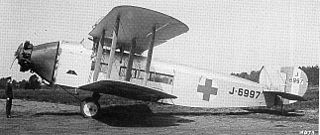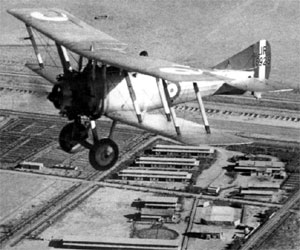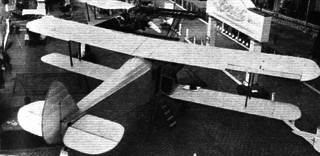Related Research Articles

Blackburn Aircraft Limited was a British aircraft manufacturer that concentrated mainly on naval and maritime aircraft during the first part of the 20th century.
The Aircraft Manufacturing Company Limited (Airco) was an early British aircraft manufacturer. Established during 1912, it grew rapidly during the First World War, referring to itself as the largest aircraft company in the world by 1918.

Airspeed Limited was established in 1931 to build aeroplanes in York, England, by A. H. Tiltman and Nevil Shute Norway. The other directors were A. E. Hewitt, Lord Grimthorpe and Alan Cobham. Amy Johnson was also one of the initial subscribers for shares.
Parnall was a British aircraft manufacturer that evolved from a wood-working company before the First World War to a significant designer of military and civil aircraft into the 1940s. It was based in the west of England and was originally known as George Parnall & Co. Ltd.

The Bristol Aeroplane Company, originally the British and Colonial Aeroplane Company, was both one of the first and one of the most important British aviation companies, designing and manufacturing both airframes and aircraft engines. Notable aircraft produced by the company include the 'Boxkite', the Bristol Fighter, the Bulldog, the Blenheim, the Beaufighter, and the Britannia, and much of the preliminary work which led to Concorde was carried out by the company. In 1956 its major operations were split into Bristol Aircraft and Bristol Aero Engines. In 1959, Bristol Aircraft merged with several major British aircraft companies to form the British Aircraft Corporation (BAC) and Bristol Aero Engines merged with Armstrong Siddeley to form Bristol Siddeley.

The Airco DH.4 is a British two-seat biplane day bomber of the First World War. It was designed by Geoffrey de Havilland for Airco, and was the first British two-seat light day-bomber capable of defending itself.

The de Havilland DH.90 Dragonfly is a 1930s British twin-engined luxury touring biplane built by the de Havilland Aircraft Company at Hatfield Aerodrome.
The Avro 558 was a British single-engined ultralight biplane built by Avro at Hamble Aerodrome.

The Bristol Ten-seater and Bristol Brandon were British single-engine biplane transport aircraft built by the Bristol Aeroplane Company in the early 1920s. Only three were built, two of which were used as civil transports and one of which served with the Royal Air Force.

The Nieuport Nighthawk was a British fighter aircraft developed by the Nieuport & General Aircraft company for the Royal Air Force towards the end of the First World War. Although ordered into production before the aircraft first flew, it did not enter large scale service with the RAF owing to unreliable engines. Re-engined aircraft did see service in Greece, serving from 1923 to 1938.

The Supermarine Sea King was a British single-seat amphibious biplane fighter designed by Supermarine in 1919. Developed from the Supermarine Baby and the Supermarine Sea Lion I, the Sea King was a single seater biplane powered by a pusher 160 horsepower (120 kW) Beardmore engine. It first flew in early 1920 and was exhibited by Supermarine at the 1920 Olympia Show in London. The company released drawings of the aircraft's design prior to the show; what it exhibited was probably a modified Supermarine Baby.

The Avro 562 Avis was a two-seat light biplane designed and built by the A.V.Roe and Company Limited at Hamble for the 1924 Lympne Light Aeroplane Trials.
The British Aircraft Manufacturing Company Limited was a 1930s British aircraft manufacturer based at London Air Park, Hanworth, Middlesex, England.

The Bristol Type 99 Badminton was a 1920s British single-seat racing biplane built by the Bristol Aeroplane Company and designed by F.S. Barnwell.
The Bristol Type 109 was a British two-seat long-distance biplane built by the Bristol Aeroplane Company at Filton Aerodrome, England.

The Bristol Type 110A was a single-engine biplane for charter work, accommodating four passengers in comfort. Designed by Frank Barnwell and built at Filton Aerodrome by the Bristol Aeroplane Company. No orders were obtained and only one aircraft was built.
The Alliance P.2 Seabird was a British single-engined long-range biplane designed by J.A. Peters to enter the Daily Mail £10,000 Atlantic Flight Prize. In the end it did not compete but became the first aircraft to fly from London (Acton) to Madrid non-stop on 31 July 1919.
The London and Provincial Fuselage Biplane was a British single-engined two-seat training aircraft of the First World War. While the aircraft demonstrated excellent manoeuvrability, only a single example was built.
The Cranwell Light Aeroplane Club was formed in 1923 by staff and students of the RAF College Cranwell to design and build light aircraft. One of the members was Flight Lieutenant Nicholas Comper who became the Chief Designer. Comper and the club designed and built four aircraft with the last three types being flown.
References
Notes
Bibliography
- Jackson, A.J. (1973). British Civil Aircraft since 1919 Volume 1. London: Putnam. ISBN 0-370-10006-9.